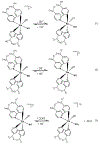Targeting the mitochondrial VDAC in hepatocellular carcinoma using a polyclonal antibody-conjugated to a nitrosyl ruthenium complex
- PMID: 29971501
- PMCID: PMC6091522
- DOI: 10.1007/s00775-018-1589-x
Targeting the mitochondrial VDAC in hepatocellular carcinoma using a polyclonal antibody-conjugated to a nitrosyl ruthenium complex
Abstract
The rational design of anti-cancer agents includes a new approach based on ruthenium complexes that can act as nitric oxide (NO) donor agents against specific cellular targets. One of the most studied classes of those compounds is based on bis(bipyridine) ruthenium fragment and its derivative species. In this work, we present the chemical and cytotoxicity properties against the liver hepatocellular carcinoma cell line HepG2 of cis-[RuII(NO+)Cl(dcbpy)2]2- conjugated to a polyclonal antibody IgG (anti-VDAC) recognizing a cell surface marker. UV-visible bands of the ruthenium complex were assigned with the aid of density functional theory, which also allowed estimation of the structures that explain the biological effects of the ruthenium complex-IgG conjugate. The interaction of cis-[RuII(NO+)Cl(dcbpy)2]3- with mitochondria was evaluated due to the potential of these organelles as anti-cancer targets, and considering they interact with the anti-VDAC antibody. The cytotoxicity of cis-[RuII(NO+)Cl(dcbpy)2]3--anti-VDAC antibody was up to 80% greater in comparison to the free cis-[RuII(NO+)Cl(dcbpy)2]3- complex. We suggest that this effect is due to site-specific interaction of the complex followed by NO release.
Keywords: Conjugated ruthenium-antibody complex; Nitric oxide delivery agent; Nitrosyl ruthenium complexes.
Figures












Similar articles
-
Release of NO from a nitrosyl ruthenium complex through oxidation of mitochondrial NADH and effects on mitochondria.Nitric Oxide. 2012 Mar 31;26(3):174-81. doi: 10.1016/j.niox.2012.02.001. Epub 2012 Feb 18. Nitric Oxide. 2012. PMID: 22349020
-
Effects on mitochondria of mitochondria-induced nitric oxide release from a ruthenium nitrosyl complex.Nitric Oxide. 2009 Feb;20(1):24-30. doi: 10.1016/j.niox.2008.10.001. Epub 2008 Oct 10. Nitric Oxide. 2009. PMID: 18950724
-
Cytotoxicity, cellular uptake, and subcellular localization of a nitrogen oxide and aminopropyl-β-lactose derivative ruthenium complex used as nitric oxide delivery agent.Nitric Oxide. 2019 May 1;86:38-47. doi: 10.1016/j.niox.2019.02.005. Epub 2019 Feb 19. Nitric Oxide. 2019. PMID: 30790696
-
The voltage-dependent anion channel (VDAC): function in intracellular signalling, cell life and cell death.Curr Pharm Des. 2006;12(18):2249-70. doi: 10.2174/138161206777585111. Curr Pharm Des. 2006. PMID: 16787253 Review.
-
VDAC Regulation: A Mitochondrial Target to Stop Cell Proliferation.Adv Cancer Res. 2018;138:41-69. doi: 10.1016/bs.acr.2018.02.002. Epub 2018 Mar 2. Adv Cancer Res. 2018. PMID: 29551129 Free PMC article. Review.
Cited by
-
Can Nitric Oxide-Based Therapy Be Improved for the Treatment of Cancers? A Perspective.Int J Mol Sci. 2023 Sep 2;24(17):13611. doi: 10.3390/ijms241713611. Int J Mol Sci. 2023. PMID: 37686417 Free PMC article.
-
Nitric oxide-donor/PARP-inhibitor combination: A new approach for sensitization to ionizing radiation.Redox Biol. 2019 Jun;24:101169. doi: 10.1016/j.redox.2019.101169. Epub 2019 Mar 15. Redox Biol. 2019. PMID: 30889466 Free PMC article.
-
Current Advances of Nitric Oxide in Cancer and Anticancer Therapeutics.Vaccines (Basel). 2021 Jan 27;9(2):94. doi: 10.3390/vaccines9020094. Vaccines (Basel). 2021. PMID: 33513777 Free PMC article. Review.
References
-
- Bonavida B (ed) (2010) Nitric oxide (NO) and cancer: prognosis, prevention, and therapy. Springer Science and Business Media, New York
-
- Serafim RA, Primi MC, Trossini GH, Ferreira EI (2012) Nitric oxide: state of the art in drug design. Curr Med Chem 19(3):386–405 - PubMed
-
- Tfouni E, Truzzi DR, Tavares A, Gomes AJ, Figueiredo LE, Franco DW (2012) Biological activity of ruthenium nitrosyl complexes. Nitric Oxide 26(1):38–53 - PubMed
Publication types
MeSH terms
Substances
Grants and funding
LinkOut - more resources
Full Text Sources
Other Literature Sources
Medical
Miscellaneous

